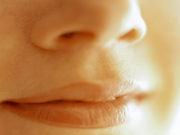Monophasic hyaluronic acid filler, Dermalax implant plus, not inferior to biphasic HA Sub-Q
THURSDAY, Feb. 9, 2017 (HealthDay News) — The monophasic hyaluronic acid (HA) filler with lidocaine, Dermalax implant plus (PLUS), is not inferior to the biphasic HA Restylane Sub-Q (Sub-Q) for correcting nasolabial folds (NLFs), according to a study published online Feb. 1 in the Journal of Cosmetic Dermatology.
Joon Hyuk Suh, M.D., from the Chung-Ang University College of Medicine in Seoul, South Korea, and colleagues enrolled 52 patients with visible NLFs in a randomized multicenter trial. Participants were injected with PLUS in one NLF and with Restylane Sub-Q in the other. Cosmetic changes were assessed in participants at two, eight, 12, 16, and 24 weeks. The 5-point Wrinkle Severity Rating Scale (WSRS) was used to rate wrinkle severity.
The researchers found that the mean improvement in the WSRS at week 24 versus baseline was 1.06 ± 0.54 and 0.69 ± 0.58 for the PLUS side and Sub-Q side, respectively. Within 30 minutes after the procedure, the average values of pain evaluated by self-assessment 100-mm visual analogue score scale were 14.65 ± 16.23 and 38.29 ± 27.27 in the PLUS and Sub-Q groups, respectively. Both fillers were well tolerated, with mild adverse reactions.
“We confirmed that the monophasic HA containing pre-incorporated lidocaine (PLUS) is not inferior to well-studied biphasic HA (Sub-Q) in correcting severe nasolabial folds for 24 weeks, and [is] less painful than biphasic HA not containing lidocaine,” the authors write.
Full Text (subscription or payment may be required)
Copyright © 2017 HealthDay. All rights reserved.








